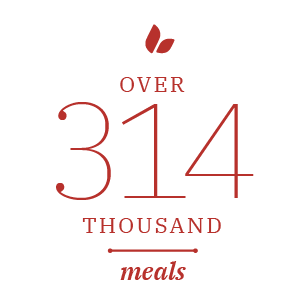—Leftovers
Reduce food waste and increase access. We work with volunteers, donors, and service agencies across Canada to rescue and redirect food.

—The Leftovers Foundation is one of Canada’s largest tech-enabled food rescue organizations. Whether you are a volunteer, business owner, or donor, there is a program for you.
The Leftovers Foundation is committed to reducing food waste, increasing access, and developing innovative, industry-leading social venture programs that change the way people think about sustainability. Our mission is to grow across Canada and provide an opportunity for hardworking volunteers, partners, donors, and service agencies to realize their visions – a world free of poverty, food waste, and environmental harm.
Our social venture programs are changing the way people think about sustainability. Help us rescue food, increase access, and protect our environment.

We provide opportunities for individuals to donate their time volunteering, food, financial resources, and expertise in various ways.
In 2020, 596,755 pounds of food were redirected from the landfill to our community members and neighbours who need it.

314,321 meals provided in 2020

$1,235,283 saved

4,776 routes completed
Join our community to rescue food, protect our environment, and fight poverty. You can get involved as a food donor, a service agency, financial donor, or a volunteer.

Lourdes Juan was inspired to start The Leftovers Foundation after witnessing how much unsold bread a single bakery in Calgary had at closing time. Shocked that there was so much good food going to waste, when so many people desperately needed food, Lourdes created Leftovers.
An Eye-Opening Experience
Back in 2012, I was asked by a cousin to help pick up excess bread from a local bakery that was going to be thrown out. The bakery had a policy to donate food at the end of their day because they would bake more than was needed, every morning, to fill their shelves – people want to buy from businesses with full, aesthetically pleasing displays. The bakery recognized that they didn’t want any fresh food to go waste, so they developed an ‘End of Day Giving Program.’ When I arrived, there was about 200 lbs. of bread, which basically took up the entire front of the store. My cousin could only take a couple bags worth for the charity he was donating to, so we were left with 100 to 175 lbs. I had no idea where to bring it, but I think the initial shock of seeing that much bread was really eye-opening for someone who doesn’t come from the restaurant or non-profit sector. We took the rest to the drop-in centre, where I knew we could donate food after work hours. When we got there, the gentleman at the loading dock told me they would use the bread by noon the next day – they were serving 3,000 meals a day.
The Early Days
It shocked me that many people in our city could use the food, and it was just going to be thrown out if we hadn’t been there to rescue it. The gears started turning in my head about how we could mobilize a lot of people to pick up from different locations and get this food to the people and organizations that could use it. I was a small business owner at the time, I didn’t have an office of my own, so I would work in coffee shops. I remember sticking around and asking if they could donate what they didn’t sell by the end of the day so I could take it to service agencies. That was the foundation of how Leftovers operates today. We take food from different donors, and we make sure that it gets to service agencies. Leftovers has morphed into – not only donating tonnes of food – but a way to creatively repurpose food that service agencies can’t take.
Community Mobilization
The community in Calgary has been really supportive. It was enough that we were able to take flight in Edmonton. Community mobilization helped us find that success and enable us to expand further into Winnipeg and Hinton as well. We’re taking a straightforward model and replicating it in areas where food can be rescued and used to serve people.
Leftovers has really made a dent in the world of food waste and rescue, not just from a per-pound perspective, but from an awareness perspective. We need to start thinking differently about food waste, particularly around climate change. When food goes into a landfill, it emits methane, a far worse pollutant than carbon dioxide. We need to start thinking about the entire food systems picture – who has access to food, who doesn’t, and the types of food available in different communities.
I see Leftovers as a nimble organization. We can incubate pilot programs that shake up our food systems by coming from a dignified approach to how we get food to people in need. Community mobilization is an important tenement of Leftovers. We’re not 10 people sitting around a table trying to figure out how to fix a broken food system. We’re every person, volunteer, donor, and service agency coming together to be a part of this food rescue movement.
Board of Directors

Lourdes
Juan
Founder & Director

Audra
Stevenson
Interim CEO

Shannon
Ramdin
Board Chair

Teresa
Goldstein
Vice Chair

Mark
Hildebrand
Treasurer

Shawna
Perron
Secretary

Keltie
Gower
Director

Kristi
Lalach
Director

Thomas
Dyer
Director

Dana
Silver
Director

Kate
Godfrey
Director
Leadership Team

Kyra
Cusveller
VP Engagement

Ania
Karzynska
VP Finance

Shelby
Montgomery
VP Programs

Darany
Touch
VP IDEA & Administration

Emily
Vilcsak
VP Marketing & Communications

Kyra
Cusveller
VP Engagement

Ania
Karzynska
VP Finance

Shelby
Montgomery
VP Programs

Darany
Touch
VP IDEA & Administration

Emily
Vilcsak
VP Marketing & Communications

Kyra
Cusveller
VP Engagement

Ania
Karzynska
VP Finance

Shelby
Montgomery
VP Programs

Darany
Touch
VP IDEA & Administration

Emily
Vilcsak
VP Marketing & Communications
Teams by City

Our
Funders
Support our programs and initiatives


Rescue
Food
Rescue food and deliver it to service agencies


